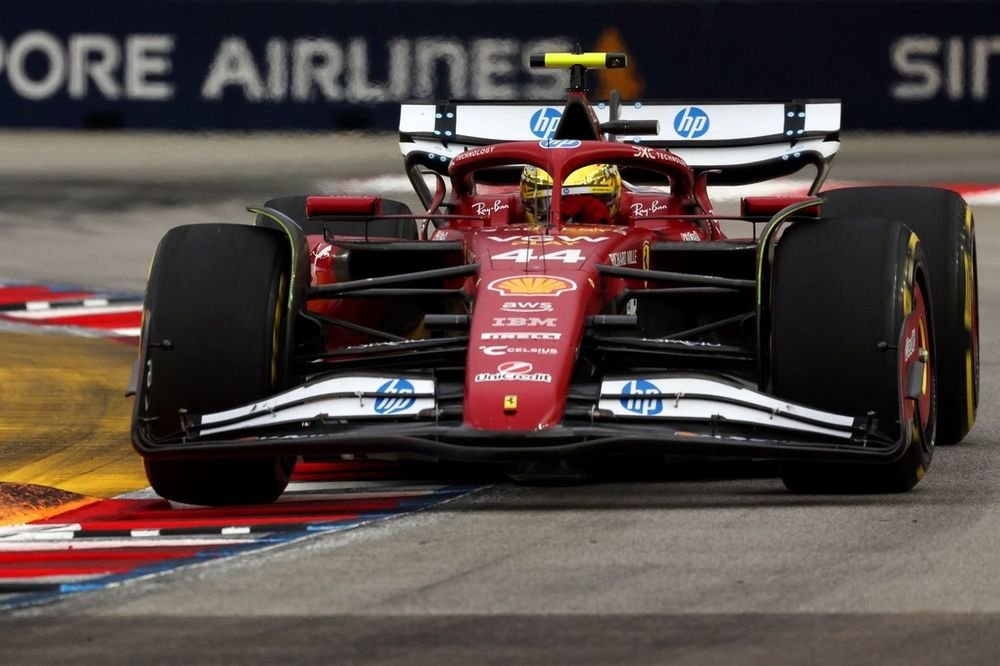On a sharp, humid evening at the Singapore Grand Prix, the atmosphere in the paddock turned tense, not just from 31 °C heat and humidity, but from uncertainty over Lewis Hamilton’s at Singapore GP compliance with red-flag rules during Free Practice 3. The seven-time world champion was placed under investigation by FIA stewards, accused of failing to sufficiently slow under red-flag conditions. As the scrutiny mounted, fans, pundits, and rivals watched closely: would Hamilton face a penalty, or would he escape unscathed?
In this article, we explore:
- The circumstances leading to the investigation
- The regulations he was alleged to have breached
- The stewards’ inquiry, evidence, and verdict
- The implications for Hamilton, Ferrari, and the Singapore GP
- Broader reflections on stewards’ consistency and F1 safety norms
The Incident: Red Flag in FP3 & Hamilton’s Actions
During FP3, Liam Lawson’s crash at Turn 7 triggered a red flag. Under F1 sporting regulations, all cars must immediately reduce speed and return to the pits under caution, observing minimum delta times in marshalling sectors.
Hamilton was observed in onboard footage and telemetry passing the stricken Lawson car, then increasing speed through remaining sectors en route back to pit entry. The stewards interpreted this as a potential red-flag infringement, and summoned him (and Ferrari) to present evidence, telemetry, radio logs, and in-car video before qualifying.
Specifically, the allegations included:
- Not sufficiently slowing through marshalling sectors
- Speeding into pit entry while red-flag was active
- Potentially driving in a manner unsafe under red-flag restrictions
Had the stewards found a breach, a grid drop and/or penalty points on Hamilton’s FIA licence might have ensued.
The Rules & Regulations: What Drivers Must Do under Red Flags
To understand why this is serious, we need to recall the relevant regulation:
- Article 37.6 (Sporting Regulations 2025): When a red flag is displayed, all cars must immediately reduce speed, proceed slowly, and return to the pit lane.
- Drivers must not merely coast or coast then accelerate; they must respect minimum delta times in each marshalling zone, ensuring the overall speed reduction is consistent.
- Unsafe driving under red-flag, such as abrupt acceleration in hazardous zones or ignoring controls, can be penalized.
These rules stem from safety imperatives: marshals may be trackside, debris may exist, and visibility is often compromised. Thus, red-flag breaches are treated seriously in F1.
The Stewards’ Inquiry & Verdict
As the investigation unfolded, stewards analyzed:
- Telemetry data – speed, braking, throttle maps
- In-car video and external footage – track positioning, control inputs
- Team radio logs – whether Hamilton was instructed or warned
- Comparisons with other cars – how others reduced speed in similar sections
After weighing evidence, the stewards concluded no further action would be taken. Their official reasoning:
- While Hamilton “appeared to be traveling at a notably high speed,” his telemetry showed he remained above the required minimum time between red flag display and pit entry, per Article 37.6a.
- His pit entry speed was judged “marginally higher” than other cars in comparable situations, but the stewards determined he maintained full control and did not drive unsafely.
- Though stewards believed greater speed reduction would have been desirable, insufficient proof exists to show an infringement under the existing rules.
Thus, Hamilton’s qualifying position stood; no grid penalty or points deduction followed.
Reactions & Analysis
Fans & Media
The verdict divided opinion. Some praised Hamilton for escaping punishment, citing stewards’ consistency issues. Others argued the stewards were too lenient given visible acceleration under red flag.
Social media saw hashtags like #HamiltonVerdict and #RedFlagRules trend across F1 fan circles. Commentators questioned whether precedent was being preserved or softened.
Rivals & Teams
Competing teams and drivers expressed frustration, citing fairness in enforcement. If a driver less prominent than Hamilton had committed the same act, would the stewards show the same leniency? That question underpins broader concerns about stewards’ discretion and consistency.
Ferrari, meanwhile, was relieved. The team had faced recent fines (e.g. for a pit-lane release involving Leclerc) and did not welcome an additional grid drop.
Hamilton & Ferrari
For Hamilton, escaping a penalty was crucial at a tight street circuit where grid position matters. Qualifying cleanly preserved his shot at a strong result. He avoided compounding pressure on Ferrari’s strategy.
But the incident nonetheless underscores margins in F1: one misstep under regulation scrutiny can derail a weekend.
Implications for the Singapore GP & Beyond
- Qualifying unaffected: Hamilton kept his qualifying spot and could compete without handicap.
- Psychological edge: Given the investigation and near-penalty, Hamilton’s mental resolve will be tested in race conditions.
- Rule scrutiny intensifies: This episode shines a light on red-flag protocols, stewards’ judgment, and clarity in enforcement.
- Precedent set: Future red-flag cases may face more intense debate; drivers will want firmer guidelines to avoid ambiguity.
Reflections on Stewarding & Safety in F1
This incident highlights recurring themes in Formula 1’s regulatory and safety environment:
- Discretion vs. clarity
The stewards must balance rules with context. Too strict an interpretation may penalize borderline cases; too lenient, and rule integrity erodes. - Driver experience matters
Hamilton’s status and track record can’t influence ruling, but his reputation may color public perceptions of fairness. - Technological transparency
Telemetry data and video give stewards strong evidence. As data granularity improves, borderline cases shrink but debates over margin will persist. - Consistency across events
Fans often point to inconsistency: similar red-flag behavior in past races sometimes got harsher penalties. The sport risks credibility loss if enforcement is perceived as uneven. - Safety first
The core reason for strict red-flag protocols is protecting lives. If a driver accelerates while marshals or debris may be present, that could endanger lives. Enforcement must reflect that priority.
Conclusion
The investigation into Lewis Hamilton under red-flag suspicion during Singapore FP3 created drama and tension, but ended with a verdict in his favor. Stewards judged that while his speed was “notably high,” Hamilton complied with minimum time requirements and maintained control, thus no breach was found.
Still, this episode underscores a few enduring truths about modern F1:
- The fine line between rule adherence and performance is narrowing.
- Stewards’ judgment and precedent will always be major factors.
- Safety regulations like red-flag enforcement are non-negotiable, and drivers must manage under those constraints.
For now, Hamilton can focus on Sunday’s race with no grid penalty – but the scrutiny will follow him deeper into the season. In Formula 1, one flagged lap can reverberate far beyond one weekend.
















